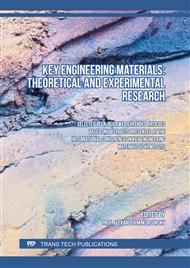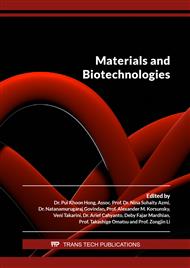[1]
N. Bhardwaj and A.N. Bhaskarwar, A review on sorbent devices for oil-spill control, Environ. Pollut. 243 (2018) 1758-1771.
DOI: 10.1016/j.envpol.2018.09.141
Google Scholar
[2]
A.M.A. Pintor, V.J.P. Vilar, C.M.S. Botelho and Rui A.R. Boaventura, Oil and grease removal from wastewaters: Sorption treatment as an alternative to state-of-the-art technologies. A critical review, Chem. Eng. J. 297 (2016) 229-255. .
DOI: 10.1016/j.cej.2016.03.121
Google Scholar
[3]
A.A. El-Samak, D. Ponnamma, M.K. Hassan, A. Ammar, S. Adham, M.A.A Al-Maadeed and A. Karim, Designing Flexible and Porous Fibrous Membranes for Oil Water Separation—A Review of Recent Developments, Polym. Rev. 60 (2020) 671-716.
DOI: 10.1080/15583724.2020.1714651
Google Scholar
[4]
B. Doshi, M. Sillanpää and S. Kalliola, A review of bio-based materials for oil spill treatment, Water Res. 135 (2018) 262-277.
DOI: 10.1016/j.watres.2018.02.034
Google Scholar
[5]
A. Tuan Hoang, V. Viet Pham and D. Nam Nguyen, A Report of Oil Spill Recovery Technologies, Int. J. Appl. Eng. Res. 13 (2018) 4915-4928.
Google Scholar
[6]
L.M.T.M. Oliveira, J. Saleem, A. Bazargan, J.L. da S. Duarte, G. McKay and L. Meili, Sorption as a rapidly response for oil spill accidents: A material and mechanistic approach, J. Hazard. Mater. 407 (2021) 124842.
DOI: 10.1016/j.jhazmat.2020.124842
Google Scholar
[7]
I. Uzunov, S. Uzunova, D. Angelova and A. Gigova, Effects of the pyrolysis process on the oil sorption capacity of rice husk, J. Anal. Appl. Pyrol. 98 (2012) 166-176.
DOI: 10.1016/j.jaap.2012.07.007
Google Scholar
[8]
I.A. El Gheriany, F. Ahmad El Saqa, A. Abd El Razek Amer and M. Hussein, Oil spill sorption capacity of raw and thermally modified orange peel waste, Alex. Eng. J. 59 (2020), 925-932.
DOI: 10.1016/j.aej.2020.03.024
Google Scholar
[9]
Q.B. Thai, S.T. Nguyen, D.K. Ho, T.D. Tran, D.M. Huynh, N.H.N. Do, T.P. Luu, P.K. Le, D.K. Le, N. Phan-Thien and H.M. Duong, Cellulose-based aerogels from sugarcane bagasse for oil spill-cleaning and heat insulation applications, Carbohydr. Polym. 228 (2020) 115365.
DOI: 10.1016/j.carbpol.2019.115365
Google Scholar
[10]
N. Lv, X. Wang, S. Peng, L. Luo and R. Zhou, Superhydrophobic/superoleophilic cotton-oil absorbent: Preparation and its application in oil/water separation, RSC Adv. 8 (2018) 30257-30264.
DOI: 10.1039/c8ra05420g
Google Scholar
[11]
J. Wang, Y. Zheng and A. Wang, Effect of kapok fiber treated with various solvents on oil absorbency, Ind. Crops Prod. 40 (2012) 178-184.
DOI: 10.1016/j.indcrop.2012.03.002
Google Scholar
[12]
J. Wang, Y. Zheng and A. Wang, Coated fiber for removal of spilled oil, Mar. Pollut. Bull. 69 (2013) 91-96.
Google Scholar
[13]
Y. Xu, Q. Su, H. Shen and G. Xu, Physicochemical and sorption characteristics of poplar seed fiber as a natural oil sorbent, Text. Res. J. 89 (2019) 4168-4194.
DOI: 10.1177/0040517519829001
Google Scholar
[14]
M.A. Hubbe, O.J. Rojas, M. Fingas and B.S. Gupta, Cellulosic oil spill sorbents, BioResources 8 (2013) 3038-3097.
Google Scholar
[15]
E. Anuzyte and V. Vaisis, Natural oil sorbents modification methods for hydrophobicity improvement, Energy Procedia 147 (2018) 295-300.
DOI: 10.1016/j.egypro.2018.07.095
Google Scholar
[16]
A. Agcaoili, M. Herrera, C. Futalan and M.D.L. Balela, Fabrication of Polyacrylonitrile Coated Kapok Hollow Microtubes for Adsorption of Methyl Orange and Cu(II) Ions in Aqueous Solution, J. Taiwan Inst. Chem. Eng. 78 (2017) 359-369.
DOI: 10.1016/j.jtice.2017.06.038
Google Scholar
[17]
A.C. Lacuesta, M.U. Herrera, R. Manalo and M.D.L. Balela, Fabrication of Kapok Paper-Zinc Oxide-Polyaniline Hybrid Nanocomposite for Methyl Orange Removal, Surf. Coat. Technol. 350 (2018) 971-976.
DOI: 10.1016/j.surfcoat.2018.03.043
Google Scholar
[18]
M.D.L. Balela, N.M. Intila and S.R. Salvanera, Adsorptive Removal of Lead Ions in Aqueous Solution by Kapok-Polyacrylonitrile Nanocomposites, Mater. Today Proc. 17 (2019) 672-678.
DOI: 10.1016/j.matpr.2019.06.349
Google Scholar
[19]
Y. Liu, J. Wang, Y. Zheng and A. Wang, Adsorption of methylene blue by kapok fiber treated by sodium chlorite optimized with response surface methodology, Chem. Eng. J. 184 (2012) 248-255.
DOI: 10.1016/j.cej.2012.01.049
Google Scholar
[20]
S.D. Tigno, M.U. Herrera and M.D.L. Balela, Hydrophobicity of functionalized TiO2-based kapok nanocomposite, Surf. Coat. Technol. 350 (2018) 857-862.
DOI: 10.1016/j.surfcoat.2018.04.017
Google Scholar
[21]
J. Wang, A. Wang and W. Wang, Robustly superhydrophobic/superoleophilic kapok fiber with ZnO nanoneedles coating: Highly efficient separation of oil layer in water and capture of oil droplets in oil-in-water emulsions, Ind. Crops Prod. 108 (2017) 303-311.
DOI: 10.1016/j.indcrop.2017.06.059
Google Scholar
[22]
P. Song, J. Cui, J. Di, D. Liu, M. Xu, B. Tang, Q. Zeng, J. Xiong, C. Wang, Q. He, L. Kang, J. Zhou, R. Duan, B. Chen, S. Guo, F. Liu, J. Shen and Z. Liu, Carbon Microtube Aerogel Derived from Kapok Fiber: An Efficient and Recyclable Sorbent for Oils and Organic Solvents, ACS Nano 14 (2020) 595-602.
DOI: 10.1021/acsnano.9b07063
Google Scholar
[23]
J. Wang and H. Wang, Eco-friendly construction of oil collector with superhydrophobic coating for efficient oil layer sorption and oil-in-water emulsion separation, Surf. Coat. Technol. 250 (2018) 243-244.
DOI: 10.1016/j.surfcoat.2018.07.016
Google Scholar
[24]
N. Zhang, Y. Zhou, Y. Zhang, W. Jiang, T. Wang and J. Fu, Dual-templating synthesis of compressible and superhydrophobic spongy polystyrene for oil capture, Chem. Eng. J. 354 (2018) 245-253.
DOI: 10.1016/j.cej.2018.07.184
Google Scholar
[25]
R.B. Gapusan and M.D.L. Balela, Adsorption of anionic methyl orange dye and lead (II) heavy metal ion by polyaniline- kapok fiber nanocomposite, Mater. Chem. Phys. 243 (2020) 122682.
DOI: 10.1016/j.matchemphys.2020.122682
Google Scholar
[26]
M. Gönen, S. Öztürk, D. Balköse, S. Okur and S. Ülkü, Preparation and characterization of calcium stearate powders and films prepared by precipitation and Langmuir-Blodgett techniques, Ind. Eng. Chem. Res. 49 (2010) 1732-1736.
DOI: 10.1021/ie901437d
Google Scholar
[27]
O.S. El Kinawy, Comparison Between Jojoba Oil and Other Vegetable Oils as a Substitute to Petroleum, Energy Sources 26 (2004) 639-645.
DOI: 10.1080/00908310490438623
Google Scholar
[28]
Y.P. Zheng, H.N. Wang, F.Y. Kang, L.N. Wang and M. Inagaki, Sorption capacity of exfoliated graphite for oils-sorption in and among worm-like particles, Carbon 42 (2004) 2603-2607.
DOI: 10.1016/j.carbon.2004.05.041
Google Scholar



